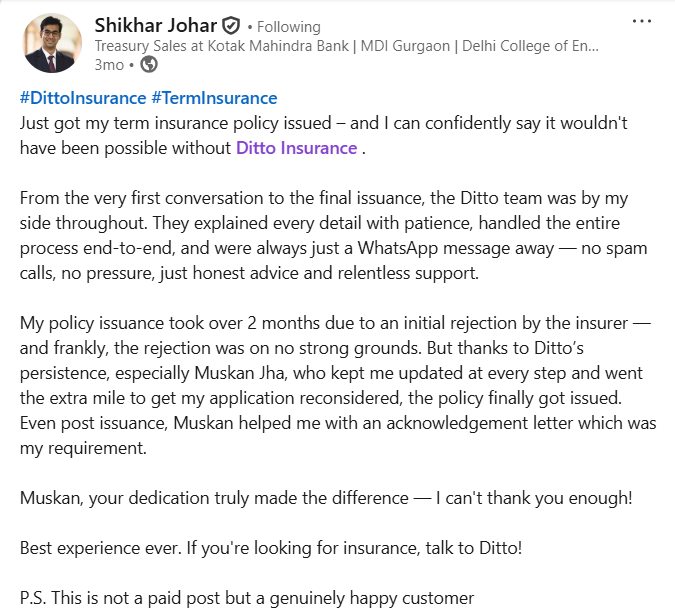| What is Limited Payment Life Insurance? Limited payment life insurance lets you pay premiums for a fixed period, like 10 or 20 years, but enjoy coverage throughout the policy term you have selected at the time of purchase. It combines long-term protection with cash value growth and tax benefits, though premiums are higher upfront. This makes it especially suitable for individuals with stable incomes who want the peace of long-term coverage while achieving financial freedom in retirement. |
Limited payment life insurance is not a separate type of life insurance but a premium payment option where you pay premiums only for a fixed, pre-set period, commonly 7, 10, 15, or 20 years. After this period, no further premiums are required while coverage continues for the chosen policy term. Once the premium payments end, the insurance remains active, offering peace of mind without ongoing payment obligations.
Instead of paying premiums regularly for the entire policy term, limited payment life insurance lets you complete payments within a shorter duration while keeping coverage active for the full term. This makes it ideal for those who want long-term protection but prefer to avoid paying premiums in retirement or later life. For a deeper understanding, check out our detailed guide comparing regular pay and limited pay insurance.
In this guide, you’ll learn what limited payment life insurance is, how it works, its features, types, pros & cons, along with Ditto’s expert advice on whether this insurance suits your needs and answers to common questions like costs and benefits.
Is limited payment life insurance right for you? Talk to Ditto’s expert advisors today and get unbiased, personalized guidance, absolutely free. Book a call now!
How does Limited Payment Life Insurance work?
Limited Pay policies have higher annual premiums compared to Regular Pay, but often result in a lower total payment over the policy term. Depending on the chosen payment duration, Limited Pay can be 10 to 100 percent more cost-effective overall. The trade-off is that annual premiums can be up to twice as high since payments are concentrated into a shorter period.
However, the advantage is that you eventually stop paying but retain protection. Over time, the policy builds cash value that you can borrow from (only in insurance + investment-based plans), surrender, or withdraw under certain conditions, and this value usually grows without being taxed until you use it.
Most limited pay policies allow flexible payment schedules (monthly, quarterly, semi-annual, or annual), and once the payment term concludes, no further premium payments are required to maintain the policy.
What Types of Payment Tenures Are Offered Under Limited Pay?
Under limited pay life insurance, you don’t have to pay premiums throughout the policy. Instead, you can choose a shorter payment window while keeping the coverage for a longer period. The main options are:
- Fixed Years: Pay premiums for a fixed period, such as 5 years, 7 years, 10 years, 12 years, 15 years, or even 20 years.
- Pay-to-Age: Pay premiums only up to a certain age, often till 60 (retirement age), while the cover continues beyond.
- Single-Pay: Technically a limited-pay option, where you make a one-time lump sum premium payment upfront and enjoy coverage for a long duration.
| Did You Know? Insurers such as HDFC Lifeb and Tata AIA now offer highly flexible limited premium payment options. Rather than being limited to fixed terms like 5-pay, 10-pay, or 15-pay, you can choose customized payment durations such as 8-pay, 11-pay, or 14-pay (or others). This flexibility helps you match premium payments to your financial comfort, career milestones, or retirement goals, while maintaining your life cover. |
Types of Limited Payment Life Insurance Policies
Limited payment life insurance comes in several types to suit different financial needs and timelines. Choosing the right one depends on your budget, how long you want to pay premiums, and how long you want the coverage to last.
| Purpose / Policy Type | Typical Premium Window | Policy / Coverage Duration | Payout Style | Ideal For | Key Notes |
|---|---|---|---|---|---|
| Pure Protection Term plan - (Ditto Recommended) | 5-15 years | 20–40 years (or till a chosen age) | Death benefit only | Those who want maximum cover but prefer to finish paying early | Lowest cost per ₹ of cover among limited-pay; no returns (unless Return of Premium variant) |
| Savings / Wealth (Endowment / Money-Back) | 5–15 years | 10–25 years (varies by plan) | Lump sum at maturity or periodic income | Conservative savers; goal-based financial planning | Can be non-par (guaranteed) or par (with bonuses); builds surrender/paid-up value |
| Whole-Life (Limited-Pay) | 10 / 15 / 20 years or till retirement (60) | To age 99/100 | Death benefit; cash values may accrue | Legacy and estate planning; lifelong coverage | Often participating (with bonuses) or guaranteed, strong paid-up value after a few years |
| Market-Linked (ULIPs) | 5–15 years | 10–20+ years (investment horizon) | Fund value at maturity; life cover during term | Investors with a long-term horizon and market risk appetite | 5-year lock-in; free fund switches allowed (limits apply); value fluctuates with market |
| Retirement (Deferred Annuity & pension plans) | 5–10 years | Deferment period and then a lifetime annuity | Regular pension (annuity) | People building retirement income | Annuity options vary; usually irreversible once chosen; death benefits depend on the option |
Regular vs Limited Pay Life Insurance Comparison
Choosing between Regular Pay and Limited Pay life insurance is key to securing long-term financial protection. They differ in payment duration, premium amounts, and commitment.
Case Study: Comparing Premium Payment Options
Let’s consider a 30-year-old male, a non-smoker, opting for the Axis Max Smart Term Plan Plus (without discounts) with a coverage of ₹1 crore for a policy term of 40 years, until age 70.
The annual premiums and total premium outgo vary significantly depending on the payment mode chosen:
| Premium Mode | Annual Premium | Payment Duration | Total Premium Outgo |
|---|---|---|---|
| Regular Pay | ₹13,185 | 40 years | ₹5,27,400 |
| 5 Pay | ₹58,020 | 5 years | ₹2,90,100 |
| 10 Pay | ₹29,912 | 10 years | ₹2,99,120 |
| 15 Pay | ₹22,957 | 15 years | ₹3,44,355 |
| Pay Till 60 (Retirement) | ₹15,516 | 30 years | ₹4,65,480 |
From this comparison, it is clear that the 5 Pay option saves the most money overall, assuming we ignore inflation and the time value of money. While Regular Pay has the lowest annual premium, it costs nearly double over the long term. On the other hand, 10 Pay or Pay Till 60 strikes the best balance for most people, offering manageable annual premiums and a shorter payment duration without drastically increasing total costs.
What are the Pros and Cons of a Limited Payment Life Insurance policy?
Understanding the advantages and disadvantages of Limited Payment Life Insurance will help you decide if it fits your financial goals and insurance needs.
Pros:
- With limited pay policies, you pay premiums only for a few years while enjoying coverage for the entire term. This not only ensures long-term security but also allows you to claim Section 80C tax benefits faster, as payments are concentrated within a shorter period.
- These policies offer cash value accumulation, allowing you to build a savings component. Savings-type limited pay policies, such as endowment, whole-life, or participating plans, build a cash value over time. On average, this value grows at around 4 to 5 percent annually, depending on the insurer and policy structure, and may be enhanced by bonuses.
- After the premium payment period ends, there are no premiums to pay during retirement or later life, providing psychological freedom in your post-working years.
- Some participating policies share a portion of the insurer’s profits with policyholders in the form of bonuses or dividends. For instance, LIC regularly declares annual bonuses to its with-profits policyholders, which can enhance the overall value of the policy.
Cons:
- Because you condense payments into fewer years, you face higher premium amounts during the payment phase, which can strain your budget.
- After purchasing the policy, it tends to be less flexible. Many insurers allow conversion from a regular pay policy to a limited pay option, but the reverse is generally not permitted.
- The policy requires solid financial planning upfront to ensure you can handle the higher premiums and optimize benefits.
- Limited pay policies require you to pay higher premiums over a shorter period, so you need enough stable income during those years, making them less suitable for people with irregular or uncertain finances.
- By paying higher premiums upfront in a limited pay policy, you incur an opportunity cost of capital, foregoing the chance to invest that money elsewhere, such as in equities or mutual funds, which may offer higher returns over time.
Why Choose Ditto for Term Insurance?
At Ditto, we’ve assisted over 7,00,000 customers with choosing the right insurance policy. Why customers like Shikhar love us:

✅No-Spam & No Salesmen
✅Rated 4.9/5 on Google Reviews by 5,000+ happy customers
✅Backed by Zerodha
✅100% Free Consultation
You can book a FREE consultation. Slots are running out, so make sure you book a call now!
Ditto’s take on getting a Limited Payment Life Insurance
Limited payment life insurance is ideal for those who want long-term coverage but prefer to pay premiums only during peak earning years. It suits individuals with steady or high incomes, minimal financial obligations, fluctuating incomes, or plans for early retirement, as it frees them from premium payments later in life.
When choosing between Limited Pay and Regular Pay, consider the time value of money, opportunity cost, and inflation. Paying higher premiums upfront under Limited Pay may not always be optimal since the extra payment could be invested elsewhere for returns. Inflation also means future premiums under Regular Pay may feel less burdensome over time.
That said, Limited Pay offers clear advantages: clearing premium obligations early, avoiding strain during retirement, and lowering lapse risk. Regular Pay, meanwhile, spreads costs over the policy term, which can suit those preferring lower annual payments or steady earning patterns.
From our experience, Limited Pay isn’t always the best fit. Heavy financial obligations may make Regular Pay more viable. We recommend consulting Ditto’s expert advisors to evaluate your income, expenses, and long-term goals to choose the best option for your situation.
Frequently Asked Questions (FAQs)
What does a Limited Pay Life Policy cost?
Premiums are higher since payments are condensed into fewer years, but total outlay can be lower. Costs depend on age, health, coverage, and payment terms. For instance, a 10-pay policy may charge nearly double the annual premium of a regular plan, but has a lower total overall cost and ends payments much earlier.
Can I convert Regular Pay to Limited Pay?
Yes, some plans allow converting a Regular Pay policy to Limited Pay, usually after 3–5 years of premiums. The new term must match original options, take effect from the next anniversary, and may require a higher premium. Availability varies by insurer, so always confirm with your provider.
Can I convert my traditional whole life policy to a limited pay plan?
Generally, no. Once a whole life policy is active, it cannot be converted to a limited pay plan. This option must be chosen when purchasing the policy. If you want limited pay benefits later, you should purchase a new policy designed with that feature.
Does cash value in limited pay policies grow faster?
Often, yes, because larger premiums over fewer years accelerate cash value accumulation. This value grows tax-deferred and can be used for loans or withdrawals (In savings-based plans like endowment or money-back schemes). Growth speed, however, depends on the policy type, insurer’s terms, and market performance in the case of linked plans.
Is limited payment life insurance suitable for everyone?
Not always. It suits those with a steady income who can afford higher upfront premiums and want to finish payments before retirement. For people with limited cash flow, other financial obligations/loans, regular payment may be more practical and affordable choic
Last updated on:







